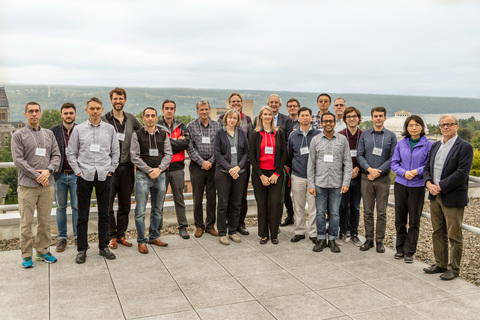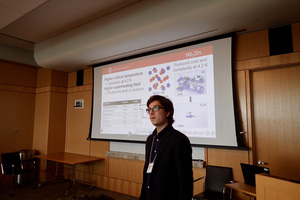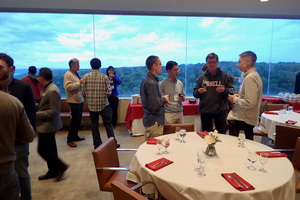CLASSE NEWS |
1 Nov 2018
Cornell Hosts HOM Workshop 2018
The workshop on Higher Order Modes in Superconducting Cavities was hosted at Cornell earlier last month. The objective of the biannual workshop was to bring together researchers studying high order mode (HOM) suppression in superconducting RF cavities. This is of interest in many applications, ranging from energy recovery linacs and light sources to linear colliders.

Attendees of the HOM workshop in October, 2018.
HOMs excited by a beam in superconducting cavities can create excessive heat load on the cryogenic system and dilute the beam quality. In the worst cases, HOMs can give rise to beam break up instability. Cornell is not alone in wanting to overcome this undesirable phenomenon. Attendees of the workshop included researchers from CERN, Fermilab, DESY, SLAC, Jefferson Lab, BNL, HZB and other facilities from around the world.

SRF graduate student, James Maniscalco, presents at the HOM workshop.
Over the course of the 21 talks during the two-and-a-half-day workshop, the group discussed the current status of both experimental and theoretical work in this area. Presenters from around the world discussed issues in electron and proton linacs, Tesla style cavities, 3rd harmonic cavities, TEM crabbing and other cavity designs relating to mitigating HOMs.
Over 20 people attended the meeting and discussed their unique approaches to HOMs. Many people needed to attend remotely via video conferencing, as the process for obtaining visas has been increasingly prolonged. Those that did attend in person were treated to dinner and a banquet at the Johnson museum, tours of the SRF lab in Newman and of the CBETA project in Wilson Lab.

Attendees enjoy the view from the reception at the Johnson Museum.
As the CBETA team prepares for construction of the main vacuum chambers of the ERL, these sessions were timely and important. Higher order modes can severely limit high current operation of superconducting cavities in an accelerator like CBETA. In order to minimize HOMs the CBETA team has designed beam line absorbers that are placed at the ends of each SRF cavity. This approach, which is also used in CESR, was found to be the most effective for the specifications of these machines.
Other approaches to reduce the errant RF interference include antenna damping and the use of waveguides.
For example, HZB in Berlin is planning on using waveguides to mitigate higher order modes. The group from HZB presented their initial models that show strong HOM suppression from this type of damping.

HOM attendees tour the CBETA machine, which uses beam line absorbers to minimize HOMs.
Many thanks to the organizers and administrators for a smooth conference. Special thanks to the CLASSE IT team for accommodating the international attendees on Zoom. The physical distance seemed to shorten drastically with the quality of the video conferencing, allowing for lively discussion.
The next HOM workshop will be held in 2020, in a location to be determined.




